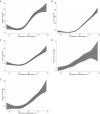Investigations concerning the impact of consumption of hot beverages on acute cytotoxic and genotoxic effects in oral mucosa cells
- PMID: 34836993
- PMCID: PMC8626505
- DOI: 10.1038/s41598-021-01995-9
Investigations concerning the impact of consumption of hot beverages on acute cytotoxic and genotoxic effects in oral mucosa cells
Abstract
Consumption of very hot beverages and foods increases the incidence of oral and esophageal cancer but the mechanisms are not known and the critical temperature is not well defined. We realized a study with exfoliated cells from the oral cavity of individuals (n = 73) that live in an area in Iran which has the highest incidence of EC worldwide. Consumption of beverages at very high temperatures is a characteristic feature of this population. We analyzed biomarkers which are (i) indicative for genetic instability (micronuclei that are formed as a consequence of chromosomal damage, nuclear buds which are a consequence of gene amplifications and binucleated cells which reflect mitotic disturbances), (ii) markers that reflect cytotoxic effects (condensed chromatin, karyorrhectic, karyolitic and pyknotic cells), (iii) furthermore, we determined the number of basal cells which is indicative for the regenerative capacity of the buccal mucosa. The impact of the drinking temperature on the frequencies of these parameters was monitored with thermometers. We found no evidence for induction of genetic damage but an increase of the cytotoxic effects with the temperature was evident. This effect was paralleled by an increase of the cell division rate of the mucosa which was observed when the temperature exceeded 60 °C. Our findings indicate that cancer in the upper digestive tract in drinkers of very hot beverages is not caused by damage of the genetic material but by an increase of the cell division rate as a consequence of cytotoxic effects which take place at temperatures over 60 °C. It is known from earlier experiments with rodents that increased cell divisions lead to tumor promotion in the esophagus. Our findings provide a mechanistic explanation and indicate that increased cancer risks can be expected when the drinking temperature of beverages exceeds 60 °C.
© 2021. The Author(s).
Conflict of interest statement
The authors declare no competing interests.
Figures



References
-
- WHO. Oral cancer. https://www.who.int/cancer/prevention/diagnosis-screening/oral-cancer/en/ (2020). (Accessed March 8, 2021).
Publication types
MeSH terms
LinkOut - more resources
Full Text Sources
Medical

